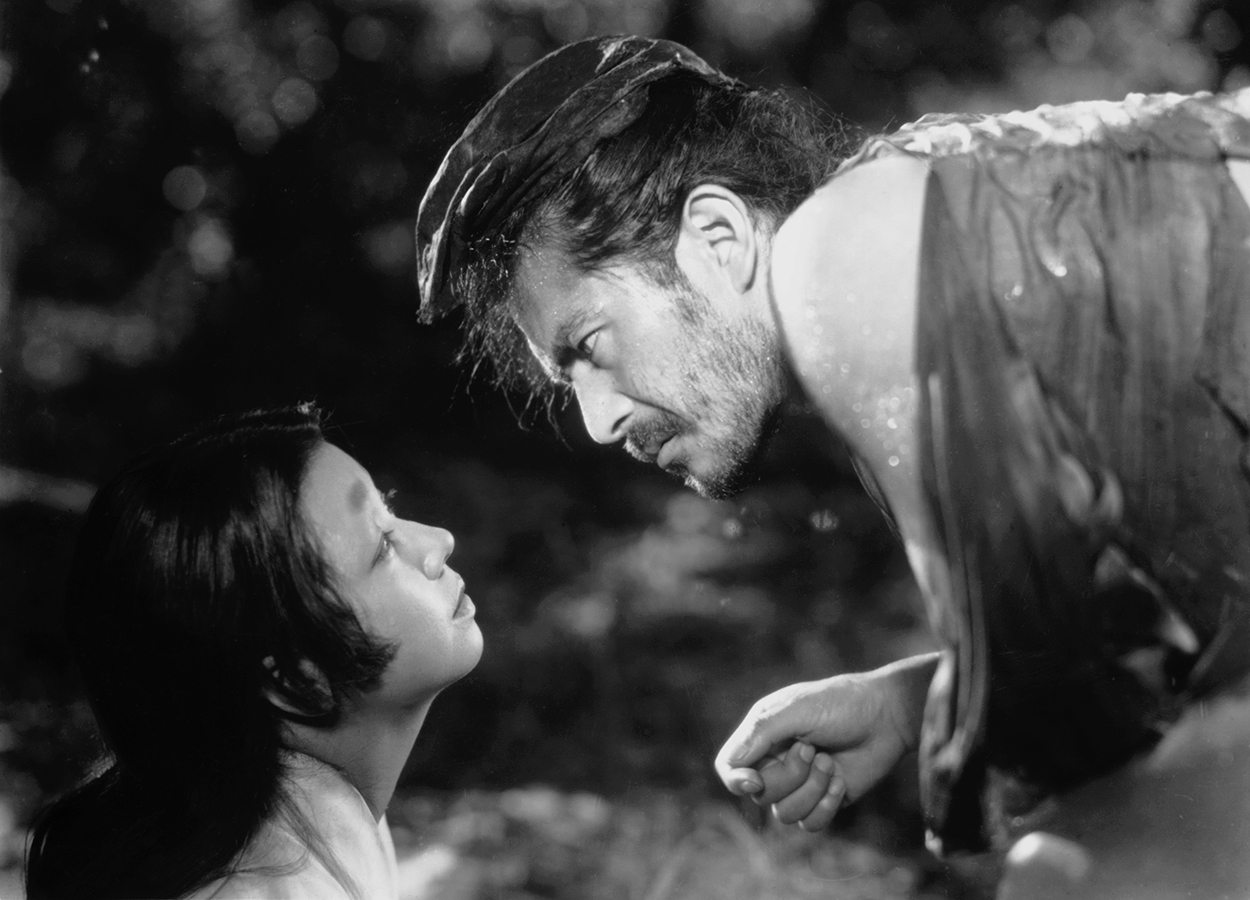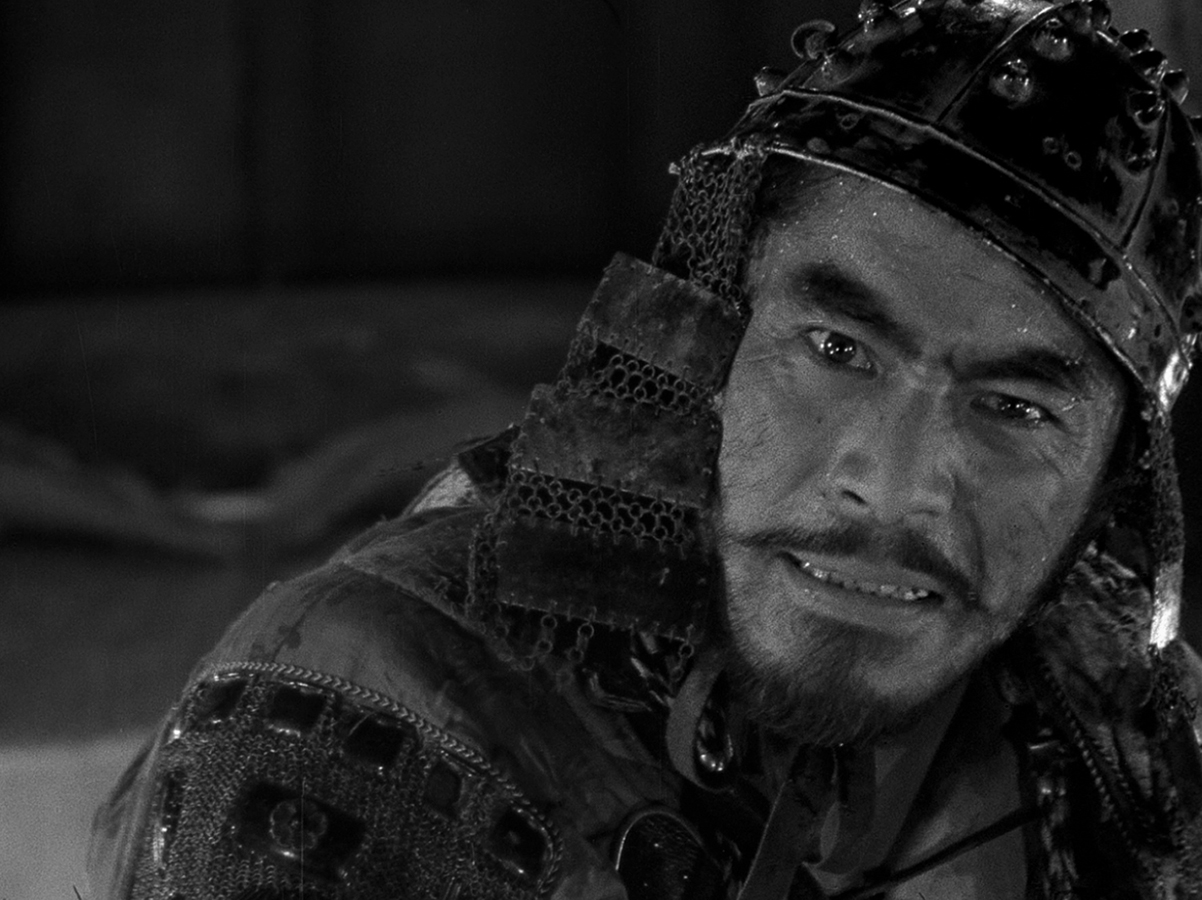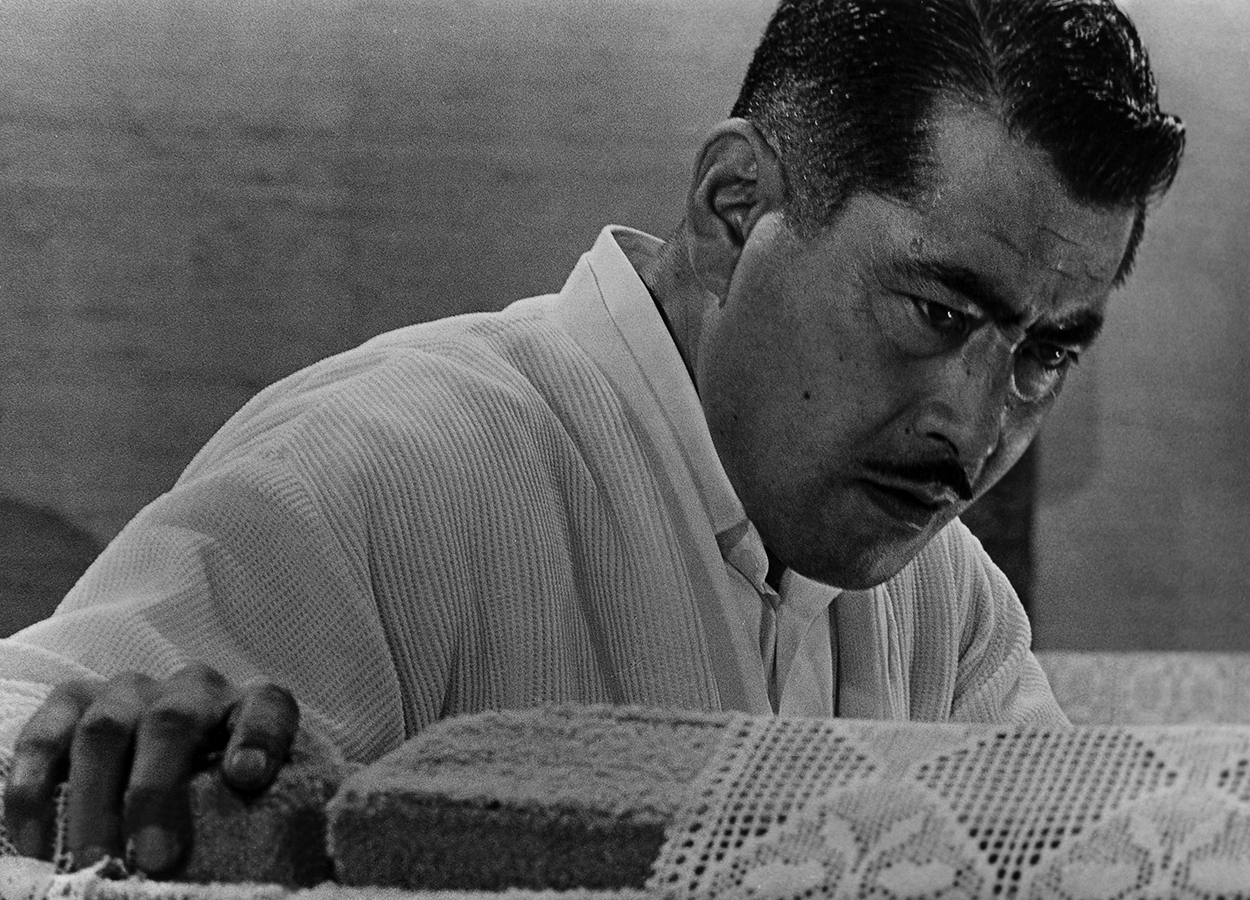RELATED ARTICLE
Tokyo Journal: Remembering Toshiro Mifune
The Criterion Collection

Everyone remembers their first time with Toshiro Mifune. With almost anyone else, such a first would be recollected with a shrug or a casual “it was . . . fine.” But Mifune induces delirious and perfect recall: of him flat on a haystack in Sanjuro, rolling in the mud in Rashomon, hotly tucked in a train bathroom in High and Low. In severe cases, numbers enter the conversation, as in: let’s rank all sixteen Mifune-Kurosawa collaborations, or “he’s like a seven in his early noirs but a solid nine in Yojimbo.” That Mifune still prompts such possessiveness might seem a little excessive. I said so to a friend, who informed me that the only acceptable and human response to Mifune is to want him supine.
For most of the past century, when people thought of a Japanese man, they saw Toshiro Mifune. A samurai, in the world’s eyes, has Mifune’s fast wrists, his scruff, his sidelong squint. Postwar Japanese cinema—led by Kurosawa, Mizoguchi, Naruse, Ozu, Kobayashi—featured many men who were bores and disappointments, and actors such as Chishu Ryu, Tatsuya Nakadai, and Takashi Shimura infused that stoop of failure with inevitability, resonance, depth. Mifune, meanwhile, embodied a different kind of failure, one that looked sexy. He may have played warriors, but they weren’t typical heroes: they threw tantrums and fits, accidentally slipped off mangy horses, yawned, scratched, chortled, and lazed. But when he extended his right arm, quick and low with a blade, he somehow summoned the tone of epics.

“There are all kinds of legends,” Mifune would say, demurely, of his first audition. When he showed up at Toho Studios in 1947, he was a starving laborer scraping by while working for the U.S. occupation forces. Mifune didn’t want to act; a photographer’s son, he was there for the job of photographer’s assistant. Somehow, his résumé ended up in a pile for a “New Faces Contest,” where he was judged by a panel of directors and actors who deemed him insubordinate and uncontrollable. “Is it true,” later interviewers would ask him, “that you refused to smile?” But one of the judges, actor Hideko Takamine (and here, the legend starts reading like someone’s fantasy cocktail party of Japanese cinematic greats), skipped out and over to Akira Kurosawa and told him that there was a boy worth looking at. When Kurosawa got there, he saw a man “reeling around the room in a violent frenzy . . . a wounded or trapped savage beast trying to break loose.”
My education on Toshiro Mifune began, naturally, with his ass. As a teen, I’d prematurely decided that one could be a Kurosawa girl or an Ozu girl—Kurosawa’s films were all about the butt and legs, Ozu’s the neck and eyes—but you couldn’t be both at once. I dismissed Kurosawa’s movies as too sweaty, a parade of testosterone with far too many swords. I preferred, I said, to be slayed by delicacy, urban irony, women: Hideko Takamine’s flushed glances, Setsuko Hara’s hands hiding her face. I lasted until college. One winter break, during a bout of flu, I let Toshiro Mifune wander into my life—he turned his back to me and said, “abayo”—and I felt myself changed. Most people, I realize, do not fever-dream about the curvature and twitch of Mifune’s ass—lashed by sheets of rain—after binging Kurosawa’s greatest hits. But I know that I am not the first to feel called upon to write about it (Pauline Kael, also a fan: “No actor can do more with his knees and his behind than Mifune”), or to have stared at it, head tilted, thinking: is that . . . butt-acting? Tarkovsky, too, would take a shot at a theory of Mifune’s lower half in Seven Samurai—why it affects him so—though he’s more indirect about it: “the samurai,” he wrote, wears a “garment that leaves most of the leg bare, and their legs are plastered with mud. And when one samurai falls down dead we see the rain washing away the mud and becoming white, as white as marble . . .” I wanted more clarity. I turned to my mother, who lives in Tokyo and has long scoffed at my pretensions. “Wait until you see it in white linen,” she said.
There’s a tendency to make Mifune sound mythical. The leading man of Kurosawa-gumi, the Emperor’s coterie, he would cement his superstar status in over 150 films in his lifetime, acting for other famed directors—Hiroshi Inagaki, Kajiro Yamamoto, Kihachi Okamoto—in roles ranging from a caped lover to a Mexican bandit. I want to make him feel more real—less Theseus, more Joe—but details from his private life simply refuse to cooperate. Here is Mifune piloting a Cessna low over his son’s elementary school courtyard, flinging red carnations out his window for his wife and other mothers on Mother’s Day. Here he is sailing out in his own motorboat into a monstrous hurricane and saving actual lives in 1958; here he is flamenco-ing away an Italian night with Gina Lollobrigida; here he is easily and gently shouldering drunken Kajiro Yamamoto—wheelchair and all—like a bag of feathers down the stairs. Finally, I find a photograph of him at the wheel of his baby—a cream-colored MG-TD—looking windswept and happy, like some normal man after a good drive. But still he resists: there’s a samurai sword balanced on the dash.
“Mifune is simply too well-built,” Kurosawa would say, according to Donald Richie. “He has too much presence.” I am caught by this measuring, weighing tone of too—the idea of Mifune’s too-much-ness—because the undeniable extremes of his attractive body and his global stardom raise some questions: how much of it is Kurosawa, how much of it is Japanomania, how much of it is craft, and how much of it is just him? In Drunken Angel (1948)—Mifune’s first film with Kurosawa—Mifune is a yakuza-nobody with late-stage TB, so he tucks a carnation into his lapel, knocks back some whisky, and rollicks in a white linen suit for a world that doesn’t care. In a club scene, we see him dance to Kurosawa’s lyrics—an unsubtle Wwwwow, wow wow!—and the women around him stare at those hips, so death-bound. Mifune doesn’t give a sense of a barre or precision—that would come later, in movies like The Bad Sleep Well or High and Low—but moves with the thin, violent brightness I associate with young geniuses, scared of standing still, taking stock, and flaming out. “I like extremes,” Kurosawa would say, “because I find them most alive.”
But there’s something more to the thrill of Mifune’s movement than extremity; he makes you want to imitate him, even if—or because—you know you can’t. One long afternoon, I watched YouTube clips of John Belushi on SNL from the midseventies, a series of samurai parodies “inspired” by Mifune. Most of the time I was clasping my cheeks—dear God, mumbo-jumbo “Japanese”—but a few seconds of it, strangely, made me laugh out loud. Schlubby Belushi was nailing that unmistakable Mifune chin-stroke from Yojimbo, with his scratching hand emerging not from a sleeve but from the V-opening of his kimono. How funny and stupid he looks—how funny we would look—imitating gestures that are now Mifune signatures. The movements so clearly don’t fit the person, which is of course what makes them parody. But what made them fit Mifune? What makes us want to play at being him? What makes some movements feel like his and his alone?
Drunken Angel

Rashomon

Seven Samurai

High and Low
Some of the allure of Mifune’s movements comes from the fact that he was the original man with no name. In a scene of Seven Samurai (1954), Mifune demands that the other six samurai recognize him as one of their own. He pulls out a samurai family registry and points at a name: my name is Kikuchiyo; see there. Takashi Shimura, the samurai leader, reads it and starts laughing. “You hardly look thirteen years old to me,” he says, and Mifune recoils, as though knifed by their laughter. We never find out his actual name. In Yojimbo (1961) and Sanjuro (1962), Mifune carries his namelessness with a lot less existential unease: when asked for his name, he looks out the window, yawns, and arbitrarily names himself by what he sees—camellias, a mulberry field. There’s nothing better than Mifune nameless, childless, and parentless, stripped of a past. Unlike the stable of Kurosawa’s types—the despairing farmer, the proud samurai, the bobbing bureaucrat—Mifune’s characters feel parachuted in from a different story. Without a “real” name, he disavows material legacies, or any orientation toward a future. Everything is about bodily attention, how he’s crossing his muscly arms and glaring at you, now. We become so used to his present-ness—his “too much presence”—that after a while we don’t even need his body on-screen to sense him. Before the final battle in Seven Samurai, we see a bunch of swords thrown from off-camera into a mud heap in the middle. In this film, Mifune is the only samurai who would fling things. We don’t need Kurosawa’s slow pan to the right to identify the thrower.
Mifune’s magnetism, in other words, did not seem to require subtitles. After the international success of Rashomon (1950), he made generations of prominent American critics reach for their best animal metaphors: he was the Emperor’s wolf, a panther, a lion, a hyena, a lynx. For Anthony Lane, Mifune was “a human hedgehog”; for Vernon Young, a “soft padding genial tiger”; for Michael Sragow, a “Japanese bull in a china shop.” For Stanley Kauffmann, Mifune in Rashomon was “one of the most purely feral performances on film—animalistic in both the bestial and the elementary senses.” Mifune was the Japanese John Wayne, they said, but it was easy to read between the lines: if Wayne rode animals, Mifune was one.
But unlike John Wayne—who, as Joan Didion wrote, suggested a world where “if a man did what he had to do, he could one day take the girl and go riding through the draw and find himself home free”—Mifune’s life on-screen centers solely around men. Women, when they do appear, feel arbitrary, mythical, temporary: it’s clear that no one is really invested in the thrums of heterosexual desire. While Mifune took part in his fair share of melodramas, in his best roles he feels unavailable, with more on his mind than garden-variety love. For those in the audience, this was a tried-and-true formula for elevated hotness—but for which audience? Toshiro Mifune cemented his reputation as an icon of masculinity right alongside Hollywood narratives of neutered Asian manhood. In 1961, Mifune provoked worldwide longing by swaggering around in Yojimbo, the same year that Mickey Rooney played the bucktoothed Mr. Yunioshi in Breakfast at Tiffany’s. Looks-wise, he’s the opposite of his predecessor, the silent film star Sessue Hayakawa—often christened the “first Hollywood sex symbol”—with his long, slim fingers and Yves Saint Laurent polish. But Mifune represents a development beyond Hayakawa’s Japanese-man-on-screen, who, despite his huge white female fanbase, was always limited to roles of the “Oriental” villain, the menace, the impossible romantic lead: in 1957, Joe Franklin would tell Hayakawa in his talk show, “There were two things we were sure of in the silent movie era; the Indians never got the best of it, and Sessue Hayakawa never got the girl.”
Mifune never wants the girl in the first place. So the men around him can’t help but watch him a little open-mouthed, as he walks his slice of world, amused by and nonchalant about the stupor he leaves in his wake. “Who is he?,” someone asks, and no one ever has a good answer. You can’t help but want to walk alongside him, to figure it out. This, of course, makes you far more curious about the man who can meet Mifune unfazed. Takashi Shimura—Kurosawa’s other leading man, the frog to Mifune’s prince—often carried this crucial, more earthy role: the consummate man of talk. In Stray Dog (1949), Mifune plays a young cop who tries to get information out of a prostitute by yelling. He fails. Later, he finds Shimura—who, he learns, is his new partner—and the girl snickering and flirting over popsicles in a booth. If Mifune shape-shifted between roles, Shimura shifted within one. He provided the necessary human, ironic anchor to Mifune’s mythic wandering, the counterpoint to Mifune’s feral rage.

For all of Mifune’s animal exuberance, his characters hinge on moments of human connection, when he claims that he is like someone else. “I am this baby,” he cries, carrying an orphan farmer’s child in his arms in Seven Samurai. “I, too, had my knapsack stolen,” confesses Mifune as the cop in Stray Dog, putting himself in the shoes of a killer. The viewer is, for a moment, startled out of the narrative by the absurd dissonance: Toshiro Mifune is claiming that he is like another sniveling man. And he sounds like he believes it. The power of the voice of a man who speaks rarely: it carries weight. So you ask: Him? How? You look harder, think further: what makes us identify with others? What leads us to help other people, even when—especially when—they do not share our background, when they do not look like ourselves?
This question of identification—of who you recognize as being like you—is central to Kurosawa’s 1963 High and Low. It’s a procedural following the story of a kidnapper who mistakenly abducts a chauffeur’s son, instead of the son of the man the driver works for: the wealthy industrialist Gondo. Mifune’s Gondo faces a reckoning: given that he was happy to pay a ransom that would’ve driven him to ruin in order to save his son’s life, would he do the same for his driver’s? To what extent can he empathize with the plight of the driver—or that of the killer? Where Mifune literally bounced off floors and walls in the early noirs, in this film he’s tense and compact, a pivot point, the brittle needle on which the compass of the story spins. He’s always somewhere, bent. We don’t see him flailing or bellowing; he ossifies his samurai’s waiting crouch into a businessman’s stiff neck and bow.
But Mifune funnels this energy into two discrete scenes, to stunning effect. In the first, he tears at his hair in the shower in between the kidnapper’s calls, and in the second, he rakes and splashes his face under the sink in a train bathroom after throwing the entirety of his fortune—the ransom—out the window. After both scenes, the camera closes in on his water-sodden face, a face that, in the space of an everyday gesture, is allowed to lose a modicum of composure. In those few seconds, the clouds part, revealing an expression not quite animal or human. We can see the fury of a younger, slim-faced Mifune throwing himself against surfaces, reflected only on the dark panes of those older eyes.
But what happens when a glorious shape-shifter stays still in one form too long? Perhaps that’s what happened to Mifune, who, after parting with Kurosawa following Red Beard (1965), was left with a single name: the Last Samurai. Despite his physicality and range, Mifune stopped shifting, cutting a similar—and increasingly declining—figure in the same old legends. The wheels spun in the air and started to slow. “Is it true that they call you Mr. Clean?” Tetsuko Kuroyanagi asks him in 1981 on her talk show. He’s sixty-one, in a comfortable yellow tweed and black turtleneck, smoking. They are laughing about what the girls in his neighborhood call him, because in those years he was often found carefully vacuuming the outside of his production studio. This man, who was once so bodily that he made you forget he had a body, shape-shifted one last time—from an aging superstar to a smaller, more ordinary legend, a man who wipes his own windows. Then he chuckles. “There’s a variety of names. That, and Old Vacuum Man,” he says, smiling that broad Mifune smile. “But I call myself the Minister of Cleaning.”
A centennial tribute to Mifune is now playing on the Criterion Channel. Watch the series trailer below:

In this early-career gem from one of the most beloved Japanese animation directors of all time, an extravagant sci-fi narrative is anchored by the transcendent power of young love and poignant observations of modern life.

What makes a “bad” movie anyway? By surveying the bombs, disasters, and secret masterpieces (dis)honored at the Golden Raspberry Awards, we can learn much about American cinema’s prevailing standards of taste.

The subject of a revelatory retrospective at last year’s Morelia International Film Festival, this groundbreaking director ushered in Mexican cinema’s golden age with vibrant explorations of the nation’s folk traditions and revolutionary past.

Though the Taiwanese director began working in commercial genres, even his earliest mainstream films contain the seeds of the inimitable style that would establish him as one of the world’s most important filmmakers.